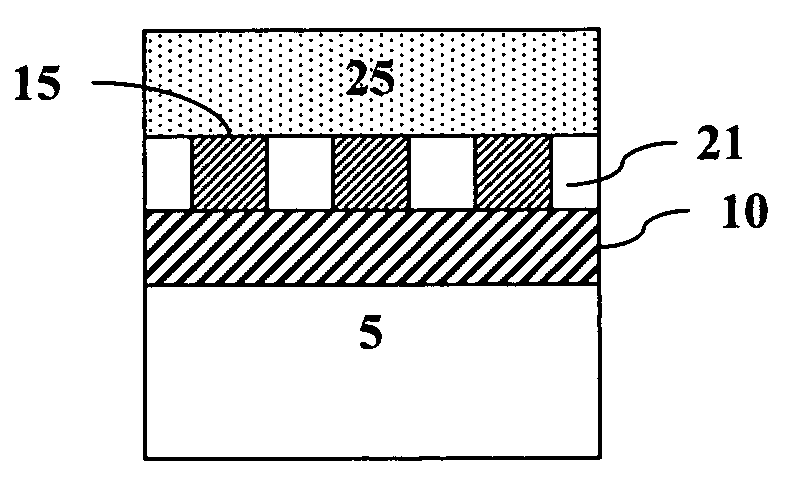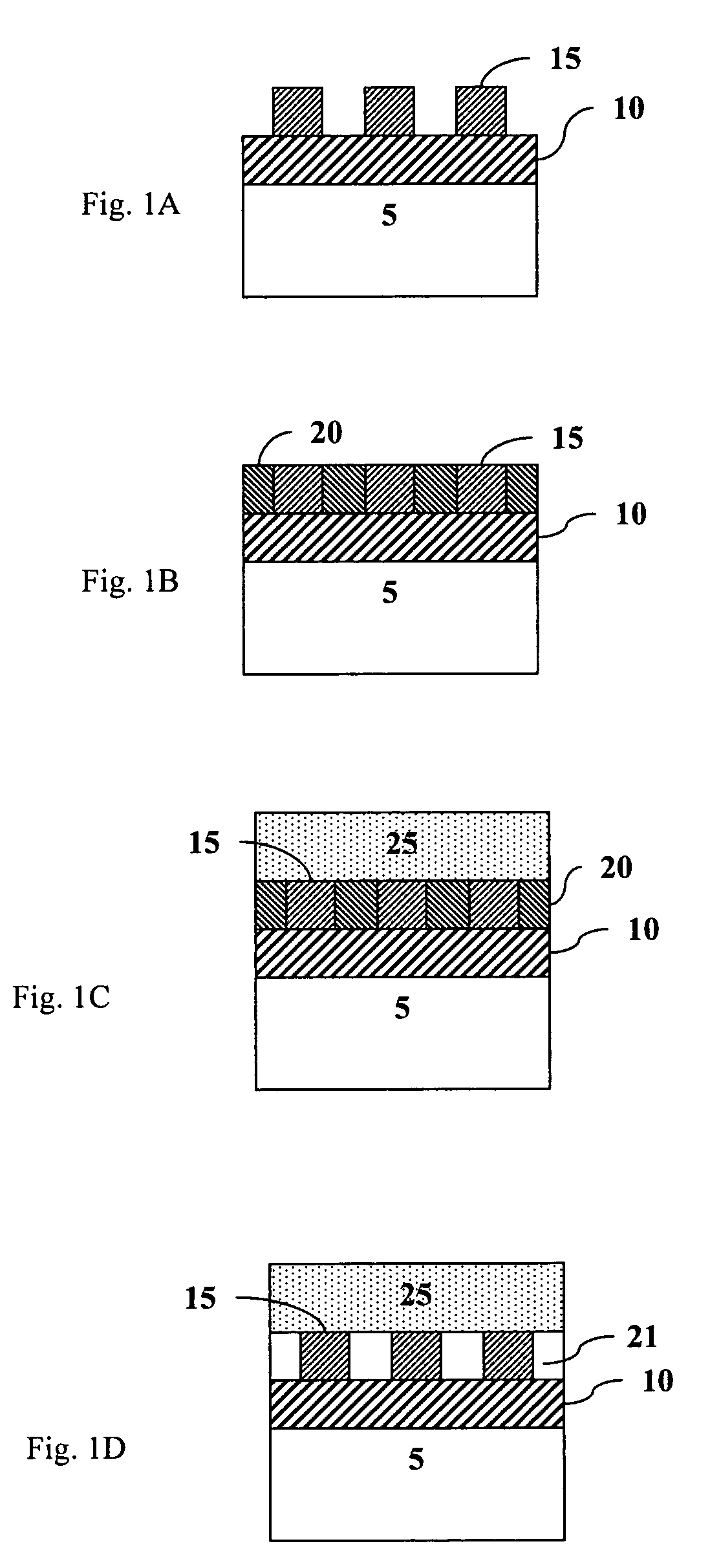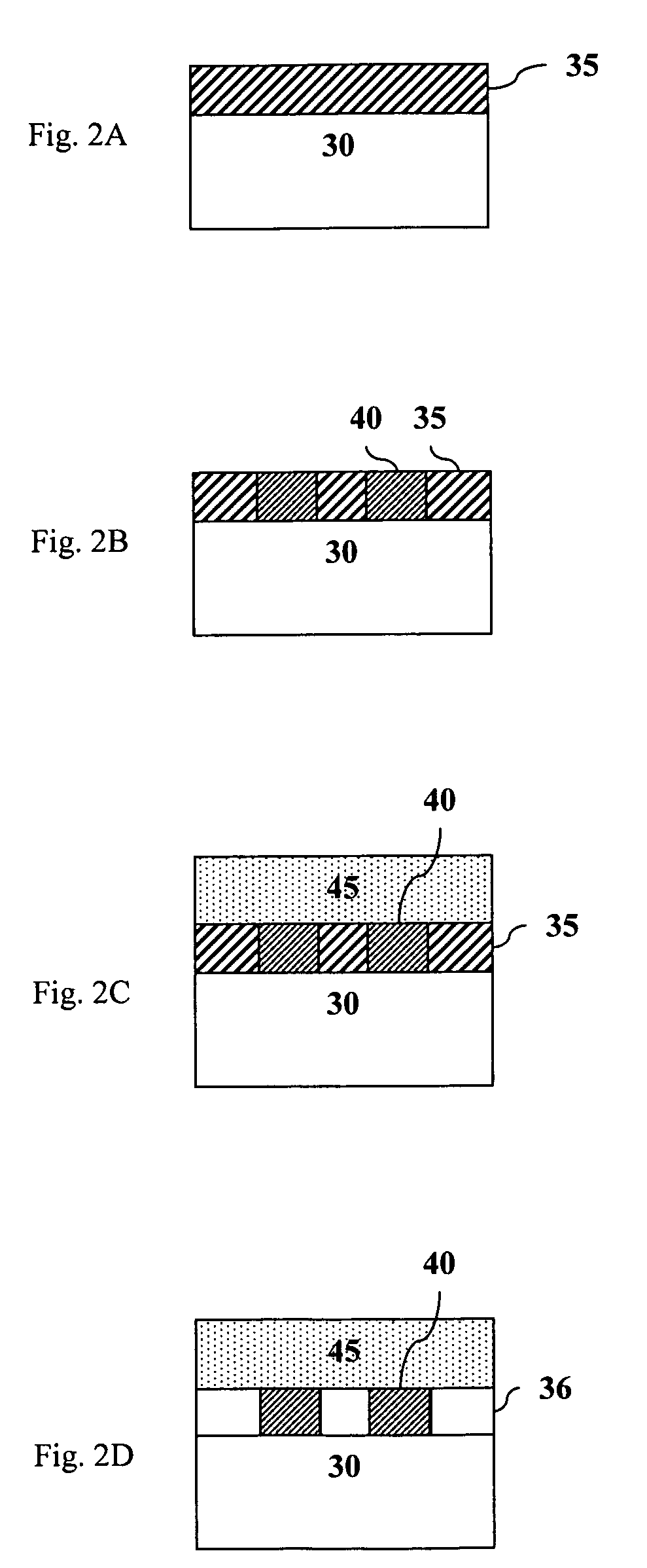Air gap formation
a technology of air gaps and air gaps, which is applied in the direction of instruments, semiconductor/solid-state device details, instruments, etc., can solve the problems of high capacitance loss, large cross-talk, and low-k materials that have not been used in all applications
- Summary
- Abstract
- Description
- Claims
- Application Information
AI Technical Summary
Benefits of technology
Problems solved by technology
Method used
Image
Examples
examples 1 – 28
EXAMPLES 1–28
[0080]Cross-linked polymer particles are prepared using the solution polymerization techniques disclosed in U.S. Pat. No. 6,420,441 B1 (Allen et al.). The compositions of the cross-linked polymers are shown in Table 1.
[0081]
TABLE 1ExampleCross-linked Polymer Particle Composition (wt / wt)1MMA / TMPTMA (50 / 50)2TMPTMA (100)3Styrene / TMPTMA (70 / 30)4HEMA / TMPTMA (70 / 30)5HEMA / ALMA (70 / 30)64-Vinyl toluene / TMPTMA (70 / 30)7HPMA / TMPTMA (70 / 30)83-(Trimethoxysilyl) propyl methacrylate / TMPTMA (70 / 30)9Styrene / PETMA (65 / 35)10HEMA / PETMA (75 / 25)11HPMA / ethoxypropyl trimethacrylate (75 / 25)12Styrene / HEMA / ethoxypropyl trimethacrylate (45 / 25 / 30)13MMA / trimethyleneglycol dimethacrylate (70 / 30)14MMA / PETA (75 / 25)15MMA / Styrene / trimethyleneglycol dimethacrylate (30 / 40 / 30)16HPMA / diethyleneglycol dimethacrylate (65 / 35)17HEMA / diethyleneglycol dimethacrylate (60 / 40)18Styrene / HPMA / EGDMA (40 / 20 / 40)19Styrene / ethoxypropyl trimethacrylate (60 / 40)203-(trimethoxysilyl)propyl methacrylate / Styrene / TMPTA (15 / 50 / 35)21...
example 30
[0082]Compositions are prepared containing cross-linked polymers of any one of Examples 1–29 in a suitable solvent for spin coating, such as propylene glycol monomethyl ether acetate. These compositions are then spin coated on a series of wafers to form a sacrificial material film. The wafer is then soft-baked at 150° C. for 1 minute to remove the solvent. An organic polysilica material containing methylsilsesquioxane and phenylsilsesquioxane and a cross-linked polymer particle as a removable porogen is then disposed on the surface of the sacrificial material as an overlayer material. The organic polysilica is soft-baked at 90° C. for 10 minutes, followed by baking at 130° C. to cure the organic polysilica material. A commercial photoresist is next applied to the organic polysilica. The photoresist is then baked, imaged, and developed. The organic polysilica material and the sacrificial material are then etched to form a pattern and the photoresist is then removed, tantalum / tantalum...
example 31
[0083]The procedure of Example 30 is repeated except that the order of steps is changed. After the sacrificial material is disposed on the wafer and dried, it is patterned using conventional lithographic techniques, followed by etching and barrier layer deposition. Copper is next deposited into the etched features on the wafer and the wafer is then planarized. Following planarization, an organic polysilica material containing methylsilsesquioxane and phenylsilsesquioxane and a cross-linked polymer particle as a removable porogen is then disposed on the surfaces of the sacrificial material and the copper lines as an overlayer material. The organic polysilica is soft-baked at 90° C. for 10 minutes, followed by baking at 130° C. to cure the organic polysilica material. The removable porogen in the organic polysilica material is then removed by heating the wafer at 250° for 1 hour to form a porous organic polysilica overlayer material. Next, the wafer is heated at 400–450° C. for 1 hour...
PUM
 Login to View More
Login to View More Abstract
Description
Claims
Application Information
 Login to View More
Login to View More - R&D
- Intellectual Property
- Life Sciences
- Materials
- Tech Scout
- Unparalleled Data Quality
- Higher Quality Content
- 60% Fewer Hallucinations
Browse by: Latest US Patents, China's latest patents, Technical Efficacy Thesaurus, Application Domain, Technology Topic, Popular Technical Reports.
© 2025 PatSnap. All rights reserved.Legal|Privacy policy|Modern Slavery Act Transparency Statement|Sitemap|About US| Contact US: help@patsnap.com



